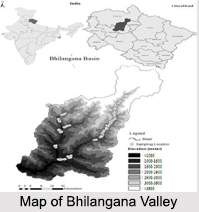 Located in the Tehri district of the state of Uttarakhand, the Bhilangana Valley is along the Bhilangana River and spreads over an area of 1009.24 sq. km. The Bhilangana Valley is surrounded from east and west by the ridges of Vasuki tal and Sahastra tal respectively, and from north and south, the valley is surrounded by the Khatling glacier and Tharti division.
Located in the Tehri district of the state of Uttarakhand, the Bhilangana Valley is along the Bhilangana River and spreads over an area of 1009.24 sq. km. The Bhilangana Valley is surrounded from east and west by the ridges of Vasuki tal and Sahastra tal respectively, and from north and south, the valley is surrounded by the Khatling glacier and Tharti division.
Climate of Bhilangana Valley
Since the Bhilangana Valley is located in the Himalayan region, the climate varies according to the elevation and gets colder as the height increases and wetter as the elevation drops. Hence, there is a change in the temperature and humidity of the region with sudden occurrences of rain, floods, high winds, snowstorms and other types of precipitation. During the summer months, the Bhilangana Valley experiences a tropical type of climate and the zone of maximum precipitation during both summer and winter lies between 1200 m and 2100 m.
Flora of Bhilangana Valley
Being a Reserve Forest area, the Bhilangana Valley is accessible to the locals and the Gujjar communities. The area around the valley had variations of exposure to sunlight and the elevation affected the climatic conditions thus giving rise to diversity in vegetation. Reports have suggested that there are 9 forest types in the western Himalayan region.
Fauna of Bhilangana Valley
Due to lack of wildlife related research in the area, there is no accurate account about faunal diversity in the Bhilangana Valley. But recent findings have revealed that the valley is as diverse in flora as it is in fauna when compared to the rest of the western Himalayas. Broadly the six Mammalian orders which are present here are Primates, Carnivora, Artiodactyla, Rodentia, Lagomorpha and Chiroptera, including endangered and rare species such as Himalayan brown bear and musk deer.
This article is a stub. You can enrich by adding more information to it. Send your Write Up to content@indianetzone.com



















